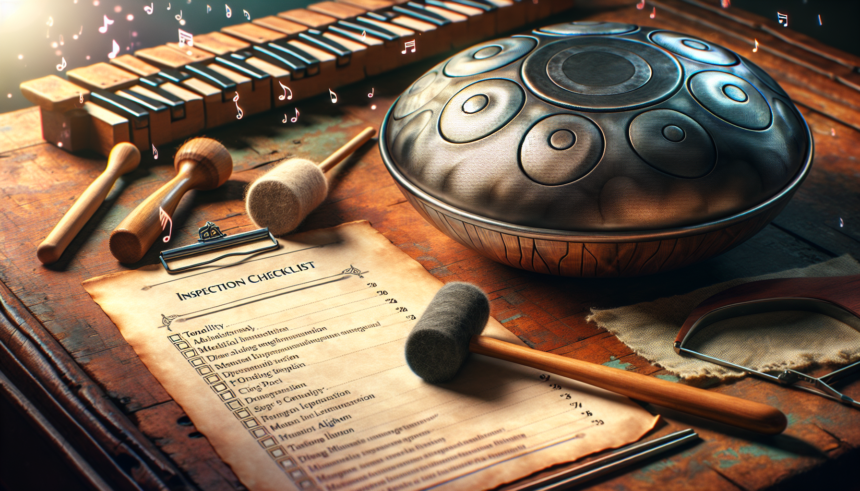The handpan, an enchanting and unique musical instrument, requires regular inspection to maintain its pristine sound and prolong its lifespan. Whether you are a novice or a professional player, understanding how to properly inspect your handpan is crucial. This article will provide a comprehensive handpan inspection checklist, along with tips and guidelines that every player should know.
1. Visual Inspection
The first step in handpan inspection is a thorough visual check. This involves looking for any signs of damage or wear and tear.
a. Surface Examination
Begin by examining the surface of the handpan. Look for scratches, dents, or rust. Even minor surface issues can affect the sound quality and should be addressed promptly. Regularly clean your handpan with a soft, lint-free cloth to prevent surface damage.
b. Notes Inspection
Each note on the handpan should be visually checked. Look for any indentations or deformations. Problems with individual notes can impact the overall harmony of the instrument.
c. Rim and Seam Check
Inspect the rim and the seam where the top and bottom shells are joined. Look for any signs of separation or irregularities that could affect the instrument’s structural integrity.
2. Tuning and Sound Quality
Regular tuning and sound quality checks are vital to maintaining the handpan’s musical integrity.
a. Tuning Check
Use a tuner app or a quality tuner device to check the pitch of each note. Even slight deviations can affect the sound. Ensure that each note is perfectly in tune and make adjustments as needed.
b. Harmonics
Play each note and listen to the harmonics. The handpan should produce clear and distinct overtones. If the harmonics sound off or muted, it might be time for a professional retuning.
c. Volume Consistency
Test the volume of each note to ensure consistency. Inconsistent volume levels can indicate internal issues or the need for retuning.
3. Physical Integrity
Regularly assessing the physical integrity of your handpan helps prevent long-term damage.
a. Shell Examination
Inspect both the top and bottom shells for any signs of buckling or deformation. The shells should maintain their smooth, curved shape.
b. Panel Alignment
Check the alignment of the note panels. Any misalignment can affect the sound quality and suggest that the instrument has suffered impact damage.
c. Symmetry
Ensure the handpan is symmetrical. Asymmetrical handpans can lead to uneven sound distribution and playing difficulties.
4. Handling and Storage
How you handle and store your handpan can significantly affect its longevity.
a. Protective Case
Always use a protective case when transporting your handpan. A good case will prevent physical damage caused by bumps and drops. Ensure the case is well-padded and fits the handpan snugly.
b. Climate Control
Store your handpan in a cool, dry place. Excessive moisture can cause rust, and extreme temperatures can lead to tuning issues. Avoid storing your handpan in direct sunlight or near radiators.
c. Handling Practices
Handle your handpan with clean, dry hands. Oils and dirt from your hands can transfer to the instrument, leading to potential corrosion and sound quality issues.
5. Regular Maintenance
Regular maintenance is essential for keeping your handpan in optimal condition.
a. Cleaning
Clean your handpan regularly to remove dust, fingerprints, and other contaminants. Use a gentle cleaner specifically designed for handpans, and avoid harsh chemicals that could damage the surface.
b. Lubrication
Apply a light coat of oil to your handpan to protect it from rust. Use a product designed for steel instruments, and ensure that it is evenly applied and wiped off excess.
c. Professional Check-ups
Schedule regular check-ups with a professional tuner or handpan maker. They can identify and resolve issues that you may overlook and ensure that your instrument remains in perfect playing condition.
Conclusion
Maintaining your handpan through regular inspection and care is crucial for ensuring its longevity and the quality of its sound. By following this comprehensive checklist, you can catch potential problems early and address them promptly, ensuring that your handpan continues to produce beautiful music for many years to come. Remember, your handpan is not just an instrument; it is a work of art that deserves the best care possible.
FAQs
1. How often should I inspect my handpan?
Ideally, you should inspect your handpan before and after each playing session. A thorough inspection once a month is recommended to catch any potential issues before they become serious problems.
2. Can I tune my handpan myself?
While minor tuning adjustments can be made with the help of a tuner, it is generally recommended to have your handpan professionally tuned. Handpans are delicate instruments, and improper tuning can lead to damage.
3. What kind of oil should I use for my handpan?
Use a light, non-corrosive oil specifically designed for steel instruments. Some popular choices include Ballistol and Phoenix Handpan Oil. Always follow the manufacturer’s instructions for application.
4. How do I prevent my handpan from rusting?
To prevent rust, keep your handpan in a dry environment, use a dehumidifier if necessary, clean it regularly, and apply a protective oil. Avoid touching the handpan with moist or dirty hands.
5. What should I do if I find a dent or scratch on my handpan?
Minor dents or scratches can sometimes be buffed out, but it is best to consult a professional if you find any damage. They can assess the extent of the damage and make necessary repairs to prevent further issues.





